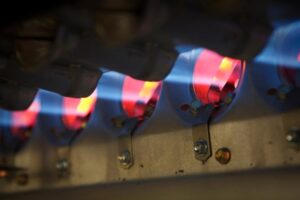If you’re like many homeowners in our area, you are likely using a gas-powered furnace in your living space. This is, after all, the most commonly found heating system in homes throughout the country, and the Cedar Falls area is no exception.
Furnace use is cost-efficient, and using a furnace is a fantastic option for many homeowners. However, while they are not inherently dangerous, when you use an appliance with natural gas in your home, there is always the slightest risk of toxic gas leaks or combustion problems. The main concern in preventing this when it comes to your gas heater is protecting the heat exchanger.
A cracked heat exchanger should always be taken seriously. If you suspect you might have a cracked heat exchanger or if you have an older furnace that hasn’t had maintenance in the last year, then please give us a call right away! Otherwise, read on to learn more about this component and the harm of a damaged one.
What Is a Heat Exchanger?
This is a great question! This component is responsible for applying heat to the air that your blower fan sends into the ventilation system (and then into your home). It has a sort of clam-shell-like setup and is a metal chamber. A number of these chambers are arranged in rows within your furnace, and this is where hot combustion gases from the burners collect.
The intense heat from these gases raises the temperature of the metal walls, making the outside of the heat exchanger very hot. This enables the furnace to apply the heat of the combustion gas to the air without letting those gases get into contact with the air.
What Causes a Cracked Heat Exchanger?
The heat exchangers within your furnace go under a lot of strain each and every winter season. Every time they get heated, the metal expands, and as they cool off when your furnace cycles off, they contract back to their original form. Over the years, this consistent expansion and contraction weakens the metal. This is a natural part of wear and tear, and part of the reason that even a well-maintained furnace has a limited lifespan (about 10-15 years). However, it can certainly lead to corrosion prematurely.
This means that even if you have a newer gas furnace, maintenance is imperative. Corrosion weakens the metal further, and eventually, small cracks will start to form along the heat exchanger.
Why This Is a Problem
The thing about these cracks, is they’re pretty much invisible to the naked eye. In fact, if you opened up your furnace while it’s off (which we don’t recommend, for a number of reasons), you wouldn’t even notice the crack. This is because they are very small, and when the heat exchanger contracts they’re hardly visible. But when it expands again with the heat, gases are able to escape through those cracks.
The most harmful of these gases is carbon monoxide (CO). CO exposure is a leading cause of health issues and even fatalities in homes each year. If you’re exposed to too much of it, you could experience dizziness, nausea, lightheadedness, and more.
Another sign that you have a cracked heat exchanger that could lead to CO exposure is if you hear a clicking sound as your furnace cycles off–this can be the metal contracting back into place. Between listening for this, staying on top of heating maintenance, and having CO detectors installed in your home, you’ll be in good shape and able to prevent a potential gas furnace hazard!
At Dalton Plumbing, Heating, Cooling, Electric and Fireplaces, Inc., your comfort is our promise! To set up an appointment in the Cedar Falls area, give us a call at the number above, email customerservice@daltonphc.com or schedule an appointment online for professional furnace repair.

